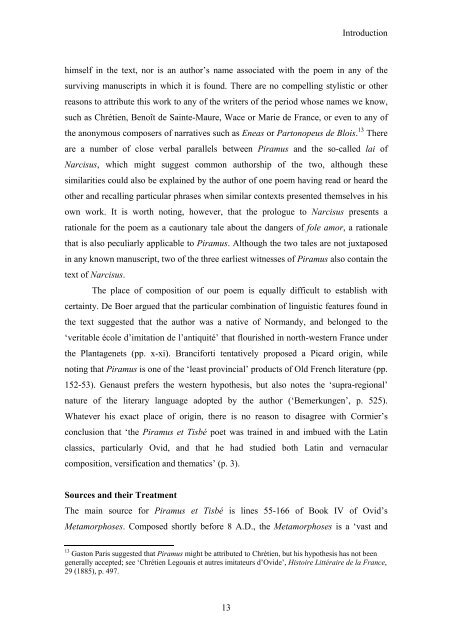You also want an ePaper? Increase the reach of your titles
YUMPU automatically turns print PDFs into web optimized ePapers that Google loves.
Introduction<br />
himself in the text, nor is an author’s name associated with the poem in any of the<br />
surviving manuscripts in which it is found. There are no compelling stylistic or other<br />
reasons to attribute this work to any of the writers of the period whose names we know,<br />
such as Chrétien, Benoît de Sainte-Maure, Wace or Marie de France, or even to any of<br />
the anonymous composers of narratives such as Eneas or Partonopeus de Blois. 13 There<br />
are a number of close verbal parallels between Piramus and the so-called lai of<br />
Narcisus, which might suggest common authorship of the two, although these<br />
similarities could also be explained by the author of one poem having read or heard the<br />
other and recalling particular phrases when similar contexts presented themselves in his<br />
own work. It is worth noting, however, that the prologue to Narcisus presents a<br />
rationale for the poem as a cautionary tale about the dangers of fole amor, a rationale<br />
that is also peculiarly applicable to Piramus. Although the two tales are not juxtaposed<br />
in any known manuscript, two of the three earliest witnesses of Piramus also contain the<br />
text of Narcisus.<br />
The place of composition of our poem is equally difficult to establish with<br />
certainty. De Boer argued that the particular combination of linguistic features found in<br />
the text suggested that the author was a native of Normandy, and belonged to the<br />
‘veritable école d’imitation de l’antiquité’ that flourished in north-western France under<br />
the Plantagenets (pp. x-xi). Branciforti tentatively proposed a Picard origin, while<br />
noting that Piramus is one of the ‘least provincial’ products of Old French literature (pp.<br />
152-53). Genaust prefers the western hypothesis, but also notes the ‘supra-regional’<br />
nature of the literary language adopted by the author (‘Bemerkungen’, p. 525).<br />
Whatever his exact place of origin, there is no reason to disagree with Cormier’s<br />
conclusion that ‘the Piramus et Tisbé poet was trained in and imbued with the Latin<br />
classics, particularly Ovid, and that he had studied both Latin and vernacular<br />
composition, versification and thematics’ (p. 3).<br />
Sources and their Treatment<br />
The main source for Piramus et Tisbé is lines 55-166 of Book IV of Ovid’s<br />
Metamorphoses. Composed shortly before 8 A.D., the Metamorphoses is a ‘vast and<br />
13 Gaston Paris suggested that Piramus might be attributed to Chrétien, but his hypothesis has not been<br />
generally accepted; see ‘Chrétien Legouais et autres imitateurs d’Ovide’, Histoire Littéraire de la France,<br />
29 (1885), p. 497.<br />
13
















